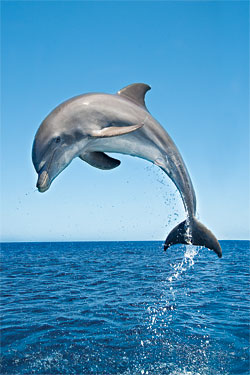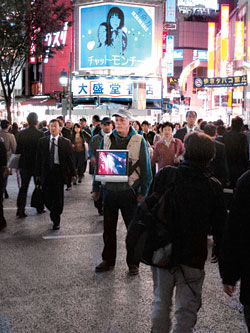
The idea that “each man kills the thing he loves” has been interpreted by many—from Oscar Wilde to Paulo Coelho—but it’s always had a particular resonance in the environmental movement, where every hiking trail and ecofriendly resort inevitably destroys or alters nature in the name of love. For 69-year-old activist Ric O’Barry, the paradox is an apt expression for his cause: the preservation of dolphins.
“Everybody loves them, right?” he asks. “But be careful with the word love.”
To O’Barry, even activities as seemingly benign as paying to see dolphins perform at SeaWorld or swimming with them in captivity constitutes abuse. “We love dolphins like they’re our family—I hear that a lot. Really? You lock your family up in a room and force them to do tricks before they eat their dinner?” O’Barry says. “The dolphin is a sonic creature; its primary sense is sound. You put one in a bare concrete box with music blaring and people shouting, of course it’s stressful! If people could see them in the wild, they’d never buy a ticket to a dolphin show.”
O’Barry is sitting in a midtown bar, his scuffed sailor shoes and messy shock of white hair, bleached by years of sun and saltwater, endearingly out of joint with the city. He’s in town to promote The Cove (opening July 31), a white-knuckle chronicle of his attempts to expose the slaughter of dolphins in Taiji, Japan, where 2,000 a year are killed, legally, in a hidden lagoon. Funded by Netscape co-founder Jim Clark, the documentary plays like a behind-enemy-lines thriller. Largely shot in jittery handheld and frantic night vision, the at-times gruesome footage—dolphins spasming in death while impaled on spears, blood spurting until the entire cove turns red—can be hard to watch, which is the point. O’Barry wants to shock viewers into activism, doing for dolphins what Al Gore’s An Inconvenient Truth did for global warming. Like Gore’s, O’Barry’s cause is deeply personal. Only he feels he is to blame.
Christmas, 1955. A teenage Richard Barry O’Feldman (he would later change his name) was released by the Navy for a fourteen-day leave. To celebrate, he took his mother and brothers to the newfangled Miami Seaquarium. “It was only the third dolphinarium in the world, and it was the best one,” he says. “Dolphins everywhere. I saw a guy in the tank, with all these creatures, and I said, ‘When I get out of the Navy, I’m coming back to get that job!’ Five years later, I did.”
O’Barry spent the sixties in the water, training dolphins and the Seaquarium’s famous killer whale. In 1964, SeaWorld opened in San Diego and welcomed over 400,000 visitors in its first year. Soon, O’Barry was training five dolphins—Susie, Patty, Kathy, Scotty, and Squirt—for a new TV show based in Florida.
For a generation of kids, Flipper provided a popular answer to the question What do you want to be when you grow up? Marine biologist! The hit show, which aired from 1964 to 1967, took place in an idyllic marine preserve and posited Flipper as a smarter Rin Tin Tin—and a proxy parent to the show’s two motherless children. In episodes like “Flipper and the Fugitive,” the dolphin saved lives, apprehended criminals, and performed the famous tail-walking trick choreographed by O’Barry. “That dock in the show, where the kids would meet Flipper? I lived in that house that whole time,” says O’Barry, who thrived in the sunny, hippie heyday of Coconut Grove, with neighbors like Tennessee Williams and David Crosby. O’Barry was good friends with Woodstock co-founder Michael Lang, who says he has a snapshot of “Ric riding a killer whale playing a wooden flute.” Another pal, Joni Mitchell, sang to the dolphins.
Then, in 1970, just as all sorts of idyllic promises were wilting (Kent State, Manson, Vietnam troops returning home), O’Barry had a life-altering experience. After a spiritual trip to India, he visited Kathy, who by then was “retired” and living alone in a tank in Florida. She was noticeably anxious (something he now calls “captive-dolphin depression syndrome”). On the day that changed everything, she swam into his arms and ceased breathing, sinking to the bottom of the tank. O’Barry emphasizes that, unlike humans, dolphins are not “automatic breathers”; they can choose to stop. He’s convinced Kathy did just that, in essence committing suicide.
Two days later, O’Barry was jailed for trying to free another dolphin. After his release, he stopped training dolphins and began fighting full time. For the next 30-odd years, with little organizational support, he would battle the dolphin- entertainment industry he had helped launch, springing dolphins from captivity and fighting the Navy’s use of them for mine detection (all chronicled in his 1988 memoir, Behind the Dolphin Smile). O’Barry says he’d be running his own “politically correct dolphin sanctuary and making two or three million dollars a year” if it hadn’t been for Kathy. Instead, he’s singularly focused on places like Taiji, where fishermen—after capturing and selling the cuter females—slaughter thousands of dolphins to sell as food.

More than 20,000 dolphins are killed in Japan annually, and it’s big business in Taiji, where O’Barry has become a public enemy, regularly surveilled by the local police. “In Japan, they call our strategy gaiatsu,” he says. “It translates to ‘external pressure.’ ” For O’Barry, the film will be successful if it can inspire a movement as effective as “Save the Whales” back in the seventies and eighties. If he can stop the slaughter in Taiji (a situation perpetuated by the government, but largely unknown to most Japanese), he can move to other dolphin-slaughtering areas, like the Faroe Islands. But he’s also coming around to good old-fashioned star power. After years of struggling for media attention, O’Barry scored worldwide coverage when actress Hayden Panettiere joined a group of surfers protesting the slaughter in Taiji. “Here’s a 19-year-old TV starlet who’s able to get more attention in fifteen minutes than I’ve been able to do in sixteen years,” he says. “So now I’m going back with Sting and Ben Stiller.”
Inevitably, of course, the goal of The Cove is also to make a celebrity of O’Barry. His son is developing a Hollywood biopic, and O’Barry just returned from Washington, where, thanks to The Cove’s festival-circuit success (it won an Audience Award at Sundance), he was able to meet with the staffs of California senators Barbara Boxer and Dianne Feinstein, handing out links to his website, SaveJapanDolphins.org. “We’re encouraging thousands of people to write to President Obama,” says O’Barry. “The times they are a-changing again. I’m sure of it!”
See Also
More From O’Barry on Secret Dolphin Slaughter — and Flipper’s Suicide